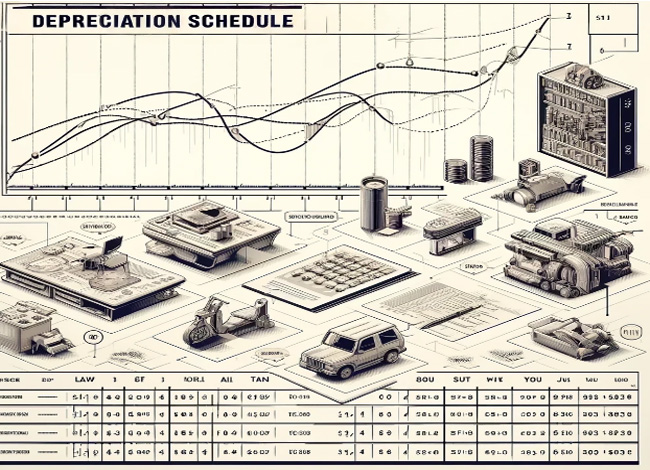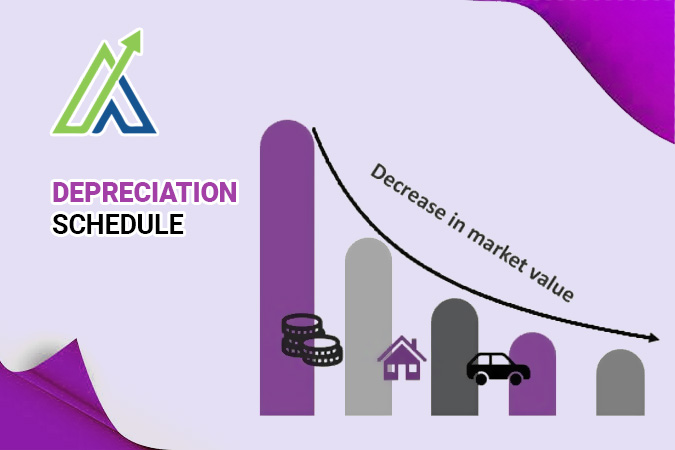A depreciation schedule is a document that states planned reductions in value of a given asset over time due to wearing out, obsolescence, or aging. It is a very critical accounting tool that helps a business allocate the cost of an asset over its useful life in a manner that not only leads to the accurate financial reporting of the business but also remains in compliance with tax regulations.

Requirements for a Depreciation Schedule
According to Indian regulations, a depreciation schedule requires the following:
- Asset Identification
Each asset should have a purchase date, cost, and description. - Useful Life Determination
The Companies Act of 2013 will provide a schedule of useful lives for different classes of assets in the case of different types of businesses. - Depreciation Method Selection
The businesses would choose either Straight-Line Method or the Written Down Value Method, based on regulatory requirements and the type of asset. - Residual Value Estimation
According to Indian standards, an estimated value at the end of the asset’s useful life should not exceed over 5% of its original cost. - Calculation of Depreciation Expense
Application of the method to compute the annual depreciation expense. - Recording and Reporting
Record the depreciation expense accurately in the books of accounts, and update the depreciation schedule at regular intervals.
Importance of a Depreciation Schedule
A depreciation schedule is important for the following reasons:
- Accurate Financial Reporting
It helps to accurately distribute the asset’s cost over its useful life, reflecting the company’s correct financial position. - Tax Compliance
Depreciation schedules help the business comply with tax regulations, as the depreciation expense is deductible for tax purposes as per the provisions under the Income Tax Act, 1961. - Asset Management
It serves as a record of an asset’s value and its remaining useful life, allowing for better management and replacement planning. - Financial Analysis
The depreciation schedules provide information that aids in the analysis of asset utilization and efficiency for strategic decision-making.
Creating a Depreciation Schedule
To create an effective depreciation schedule, follow these steps:
- Inventory Assets
Make a list of all the assets for which depreciation is required, including details of the purchase date, the purchase cost, and a brief description. - Estimate Useful Life and Residual Value
Evaluate the useful life according to the schedule provided in the Companies Act, 2013, as well as the residual value. - Choose Depreciation Method
Opt for the Straight-Line Method or the Written Down Value Method as per the type of asset and the guidelines provided by the regulatory authority. - Calculate Annual Depreciation
Calculate the annual depreciation expense using the chosen method. - Record Depreciation Expense
In the financial records, record the depreciation expense for each asset. - Update Regularly
Update the depreciation schedule at regular intervals when there are new purchases, disposals, or a change in the estimates.
Example of a Depreciation Schedule
Here’s a simple example using the Written Down Value Method for an asset with a cost of ₹10,000 and a depreciation rate of 15% per annum:
| Year | Beginning Book Value | Depreciation Expense | Ending Book Value |
| 1 | ₹10,000 | ₹1,500 | ₹8,500 |
| 2 | ₹8,500 | ₹1,275 | ₹7,225 |
| 3 | ₹7,225 | ₹1,083.75 | ₹6,141.25 |
| 4 | ₹6,141.25 | ₹921.19 | ₹5,220.06 |
| 5 | ₹5,220.06 | ₹783.01 | ₹4,437.05 |
The following formula calculates the annual depreciation expense in this example: Depreciation Expense = Beginning Book Value × Depreciation Rate
Questions to test your Understanding
Qus 1: Which of these details are required for asset identification in the depreciation schedule?
- Depreciation method and useful life
- Purchase date, cost, and description
- Tax compliance and financial analysis
- Residual value and annual depreciation
Qus 2: According to the Companies Act of 2013, what is the percentage of an asset’s residual value at its maximum at the end of its useful life?
- 10% of its original cost
- 5% of its original cost
- 15% of its original cost
- 20% of its original cost
Qus 3: Which of the following options persists for businesses to choose in their depreciation as per the Companies Act, 2013?
- Use the sum-of-the-years’ digits method and the units of production method.
- Declining balance method and straight-line method
- Use both the written-down value method and the straight-line method.
- Double-decreasing balance method and units of production method
Qus 4: The primary goal of the depreciation schedule in financial reporting is:
- Determine the future market value of the asset.
- Distribute an asset’s cost over its useful life.
- Estimate the insurance premium on the asset.
- Determine the salvage value of the asset.
Qus 5.Why is updating the depreciation schedule such a critical practice?
- Enhance the residual value of the assets.
- Ensure compliance with the company’s marketing strategy.
- Keep accurate records for new purchases, disposals, or any changes in estimates.
- Enhance the company’s sales strategy.
Conclusion
A depreciation schedule becomes an important instrument for business because it allows one to assign the cost of a tangible asset over the course of its life in accordance with Indian laws. Therefore, knowledge about depreciation and its recognition would help business entities ascertain relevant information necessary for maintaining their proper financial statements, abiding by the tax laws in vogue, and controlling their business assets. Properly maintained depreciation schedules can be very helpful in making proper decisions with regard to the use of assets, supporting the process of decision-making with regard to the financial health of the organisation.
FAQ's
The steps include:
- Inventorying assets with details of purchase date, cost, and description.
- Estimating useful life and residual value.
- Choosing a depreciation method.
- Calculating the annual depreciation.
- Keeping track of depreciation expenses.
- The schedule is regularly updated for new purchases, disposals, or changes in estimates.

